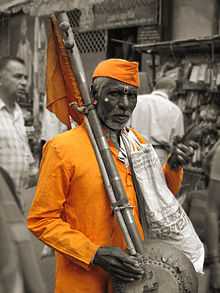Varkari

Varkari (meaning "a pilgrim") is a Vaishnava religious movement (sampraday) within the bhakti spiritual tradition of Hinduism, geographically associated with the Indian states of Maharashtra and northern Karnataka. Varkaris worship Vithoba (also known as Vitthal), the presiding deity of Pandharpur, regarded as a form of Krishna. Saints and Gurus of Bhakti movement associated with the Varkari sect include Dnyaneshwar, Namdev, Chokhamela, Eknath, and Tukaram, all of whom are accorded the title of Sant.
The Varkari movement includes the worship of Krishna in the form of Vithoba and a duty-based approach towards life emphasising, moral behavior and strict avoidance of alcohol and tobacco, strict Lacto-vegetarian diet and fasting on Ekadashi day (twice a month), self-restraint (brahmacharya) during student life, equality and humanity for all rejecting discrimination based on caste or wealth, the reading of holy books by all castes, the reading of the Haripath every day and regular bhajan and kirtan.
Influence
The Varkari tradition has been part of Hindu culture in Maharashtra since the thirteenth-century CE, when it formed as a panth (community of people with shared spiritual beliefs and practices) during the Bhakti movement. Varkaris recognise around 50 poet-saints (sants) whose works over a period of 500 years were documented in an eighteenth-century hagiography. They consider these sants to have a common spiritual line of descent.[1]
Varkaris look upon God as the Ultimate Truth and ascertained grades of values in social life but accepted ultimate equality among men. Varkaris prostrated in front of each other because "everybody is Brahma" and stressed individual sacrifice, forgiveness, simplicity, overcoming passions, peaceful co-existence, compassion, non-violence, love and humility in social life.
The Varkari poets put God-realisation (haripath) in simple terms in small booklets of verse. Each saint extolled japa, chanting the Lord's name. Dnyaneshwar, Namdev, Eknath, Tukaram, Santanji Jagnade and other Marathi Bhakti saints of the Varkari sect tried to mould the attitude of the common people, which included low castes and women, to have a kind of detachment and the courage of one's convictions in the face of evil forces.
Pilgrimages
Varkari people undertake an annual pilgrimage (vari) to Pandharpur, gathering there on Ekadashi (the 11th day) of the Hindu lunar calendar month of Aashaadha (which falls sometime between late June to July in the Gregorian calendar). The pilgrims carry the palkhis (palanquins) of the saints from their places of samadhi (enlightenment or "spiritual birth"). The tradition of carrying the paduka (sandals) of the sants in a palkhi was started by the youngest son of Tukaram, Narayan Maharaj, in 1685. Further changes were brought to the pilgrimage by descendants of Tukaram in the 1820s and by Haibatravbaba, a courtier of the Scindias who was also a devotee of Dnyaneshwar.,[2][3]
Devotees of Vithoba were holding pilgrimages prior to the 14th century.[4] In the present day, about 40 palkhis and their devotees from all over Maharashtra do so.[5] Another pilgrimage is celebrated on the Ekadashi of the month of Kartika, which falls in November of Gregorian Calendar.
Events such as Ringan and Dhava are held during the pilgrimage. During the Ringan, a sacred horse called Maulincha Ashva, who is believed to be the soul of the saint whose idol is being carried in the Palki, runs through the rows of pilgrims who try catching the dust particles kicked off and smear their head with the same. Dhava is another kind of race where everyone wins and it is held to commemorate the manner in which Tukaram first saw the temple at Pandharpur and started running in sheer exhilaration.[6]
Lifestyle of Varkari
Varkari wear tulasi-mala (string of beads made from Indian Basil plant). They only consume Lacto-vegetarian (satvik) food. Furthermore, like many other Vaishnav sects, they refrain from using onion and garlic in their cooking. Sect members also refrain from intoxicating substances such as alcohol.[7]
Notable saints

- Dnyaneshwar
- Muktai
- Namdev
- Sena Nhavi
- Chokhamela
- Bhanudas
- Eknath
- Tukaram
- Narahari Sonar
- Savata Mali
- Kanhopatra
- Bahinabai
Important Places
Following are the five important places for Warkari Sampradaya.
Literature
- Dnyaneshwari, by Dnyaneshwar
- Tukaram Gatha, by Tukaram
- Sopandevi, by Sopandeo
- Namdev-Gatha, by Namdev
- Eknathi-Bhagwat, by Eknath
- Amrutanubhav, Dnyaneshwar
- Haripath by Dnyaneshwar and Eknath
- Shri Gajanan Vijay Granth on Gajanan Maharaj by Dasganu Maharaj
References
- ↑ Schomer, Karine; McLeod, W. H., eds. (1987). The Sants: Studies in a Devotional Tradition of India. Motilal Banarsidass. pp. 3–4. ISBN 9788120802773.
- ↑ "The wari tradition". Wari Santanchi. Retrieved 8 September 2014.
- ↑ Mokashi, Digambar Balkrishna; Engblom, Philip C (Translator) (1987). Palkhi: An Indian Pilgrimage. Albany: State University of New York Press. p. 18. ISBN 0-88706-461-2.
- ↑ Gethe, Subhash. "Varkari Movement". Retrieved 8 September 2014.
- ↑ Hindu.com and page 21 of VidyaOnline.net
- ↑ Mokashi, Digambar Balkrishna; Engblom, Philip C (Translator) (1987). Palkhi: An Indian Pilgrimage. Albany: State University of New York Press. p. 264. ISBN 0-88706-461-2.
- ↑ Dikshit, S H (1971). Varkari. Wai Maharashtra: Marathi Vishwakosh. Retrieved 3 April 2015.
Further reading
- Iwao, Shima (June–September 1988). "The Vithoba Faith of Maharashtra: The Vithoba Temple of Pandharpur and Its Mythological Structure". Japanese Journal of Religious Studies (Nanzan Institute for Religion and Culture) 15 (2–3): 183–197. ISSN 0304-1042. Archived from the original on 2009-03-26.